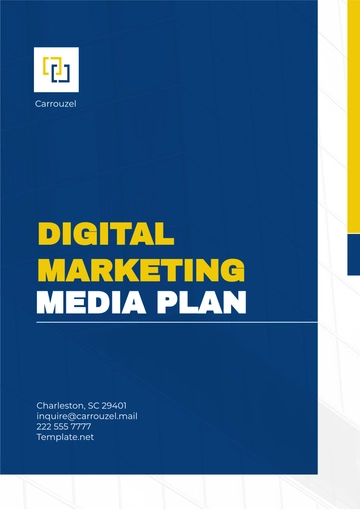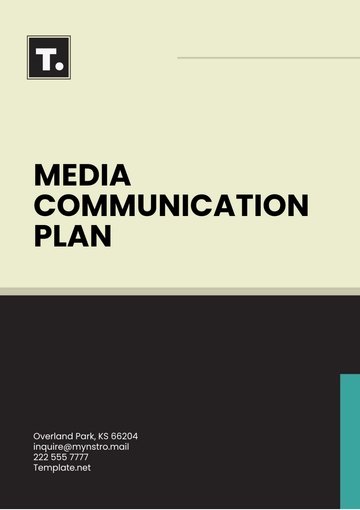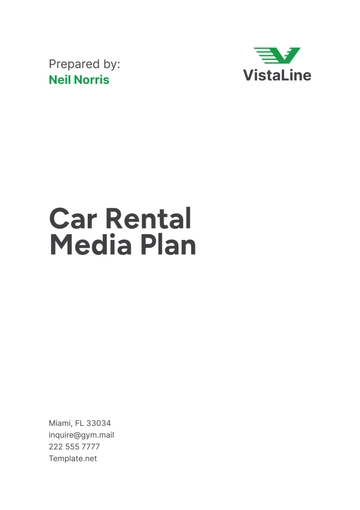Free Media Relations Plan

Prepared by:
[YOUR NAME]
[YOUR COMPANY NAME]
1. Executive Summary
This Media Relations Plan is designed to strengthen relationships with the media, enhance brand visibility, and ensure consistent messaging across all communications. The plan defines goals, key messages, target audiences, outreach strategies, and guidelines for handling media inquiries and crises. By following this plan, the organization aims to establish a positive public image and build credibility with media outlets and the public.
2. Objectives
The primary objectives of this Media Relations Plan are to:
Build and maintain positive relationships with media outlets.
Promote key messages and announcements to shape public perception.
Manage reputation through proactive and reactive media strategies.
Respond effectively to crises with clear, consistent messaging.
Position the organization as a thought leader in the industry.
3. Target Audiences
Primary Media: National and local news outlets, industry publications, influential blogs, and online news platforms.
Secondary Audiences: Stakeholders, including customers, investors, partners, and internal teams who benefit from media exposure and messaging.
4. Key Messages
Consistent messaging is essential to build credibility and reinforce the organization’s values. Below are examples of key message categories, which should be customized to align with current goals:
Mission and Vision: Communicate the organization’s mission, vision, and commitment to excellence.
Product or Service Highlights: Promote unique benefits, quality, and innovations in products or services.
Company Achievements: Share milestones, awards, and positive financial performance.
Community Impact: Emphasize involvement in community initiatives, environmental responsibility, and social impact.
5. Media Outreach Strategies
Press Releases: Share press releases for key announcements like product launches, leadership changes, and partnerships.
Media Pitches: Tailor pitches to match journalists' interests and relevance to the organization.
Media Kits: Provide a kit with organizational info, fact sheets, images, and executive bios for accurate reporting.
Press Events: Host press conferences and media events for significant announcements, followed by relationship-building.
Editorial Calendars: Sync outreach with publication schedules for maximized coverage opportunities.
Social Media: Amplify coverage, share updates, and engage in real-time on social media platforms.
6. Media Contact List
Maintain a detailed media contact list that includes:
Names of journalists, editors, and media influencers relevant to the organization’s industry.
Contact information, including phone numbers, email addresses, and preferred communication channels.
Past interactions and coverage to personalize future outreach.
7. Crisis Communication Plan
To handle unexpected crises, a proactive crisis communication strategy is crucial:
Crisis Team: Assemble a crisis response team, including PR representatives, legal advisors, and executive spokespersons.
Preparation: Develop holding statements, FAQs, and scenario-based responses for likely crises.
Immediate Response: Acknowledge the issue promptly, assure the public of actions being taken, and offer initial responses to media inquiries.
Follow-Up Communication: Provide ongoing updates as the situation develops and ensure that all public statements are coordinated across platforms.
Media Monitoring: Track media coverage and public sentiment to gauge the effectiveness of crisis response and adjust messaging if necessary.
8. Timeline of Activities
Activity | Description | Responsible Team | Timeline |
|---|---|---|---|
Media Outreach | Initial outreach to introduce the organization to new media. | PR Team | Start of Each Quarter |
Press Release Schedule | Scheduled releases for key events, product launches, etc. | PR Team | Monthly |
Media Events | Host events for significant updates or announcements. | PR & Events Team | As needed |
Crisis Drills | Conduct crisis simulation exercises. | Crisis Team | Annually |
9. Media Monitoring and Evaluation
Use monitoring tools like Mention, Brandwatch, and Google Alerts to track media mentions, assess sentiment, and observe competitor coverage.
Evaluate the success of media efforts by measuring media reach, quality of coverage, frequency of mentions in prominent publications, sentiment in media coverage, and social media engagement and audience feedback.
Conduct quarterly reviews to assess progress, refine messaging, and adjust strategies based on evolving media trends.
10. Continuous Improvement
Feedback Collection: Gather feedback from media contacts to improve the organization’s media relations approach.
Training Sessions: Offer regular media training sessions to executives and spokespersons to ensure effective communication with journalists.
Plan Updates: Review and update the Media Relations Plan annually to incorporate changes in media trends, organizational goals, and lessons learned.
- 100% Customizable, free editor
- Access 1 Million+ Templates, photo’s & graphics
- Download or share as a template
- Click and replace photos, graphics, text, backgrounds
- Resize, crop, AI write & more
- Access advanced editor
Discover the ultimate solution for crafting compelling media strategies with the Media Relations Plan Template from Template.net. This editable and customizable resource empowers you to tailor your PR approach seamlessly. Compatible with our Ai Editor Tool, it ensures effortless editing for your unique needs. Elevate your media outreach effortlessly.
You may also like
- Finance Plan
- Construction Plan
- Sales Plan
- Development Plan
- Career Plan
- Budget Plan
- HR Plan
- Education Plan
- Transition Plan
- Work Plan
- Training Plan
- Communication Plan
- Operation Plan
- Health And Safety Plan
- Strategy Plan
- Professional Development Plan
- Advertising Plan
- Risk Management Plan
- Restaurant Plan
- School Plan
- Nursing Home Patient Care Plan
- Nursing Care Plan
- Plan Event
- Startup Plan
- Social Media Plan
- Staffing Plan
- Annual Plan
- Content Plan
- Payment Plan
- Implementation Plan
- Hotel Plan
- Workout Plan
- Accounting Plan
- Campaign Plan
- Essay Plan
- 30 60 90 Day Plan
- Research Plan
- Recruitment Plan
- 90 Day Plan
- Quarterly Plan
- Emergency Plan
- 5 Year Plan
- Gym Plan
- Personal Plan
- IT and Software Plan
- Treatment Plan
- Real Estate Plan
- Law Firm Plan
- Healthcare Plan
- Improvement Plan
- Media Plan
- 5 Year Business Plan
- Learning Plan
- Marketing Campaign Plan
- Travel Agency Plan
- Cleaning Services Plan
- Interior Design Plan
- Performance Plan
- PR Plan
- Birth Plan
- Life Plan
- SEO Plan
- Disaster Recovery Plan
- Continuity Plan
- Launch Plan
- Legal Plan
- Behavior Plan
- Performance Improvement Plan
- Salon Plan
- Security Plan
- Security Management Plan
- Employee Development Plan
- Quality Plan
- Service Improvement Plan
- Growth Plan
- Incident Response Plan
- Basketball Plan
- Emergency Action Plan
- Product Launch Plan
- Spa Plan
- Employee Training Plan
- Data Analysis Plan
- Employee Action Plan
- Territory Plan
- Audit Plan
- Classroom Plan
- Activity Plan
- Parenting Plan
- Care Plan
- Project Execution Plan
- Exercise Plan
- Internship Plan
- Software Development Plan
- Continuous Improvement Plan
- Leave Plan
- 90 Day Sales Plan
- Advertising Agency Plan
- Employee Transition Plan
- Smart Action Plan
- Workplace Safety Plan
- Behavior Change Plan
- Contingency Plan
- Continuity of Operations Plan
- Health Plan
- Quality Control Plan
- Self Plan
- Sports Development Plan
- Change Management Plan
- Ecommerce Plan
- Personal Financial Plan
- Process Improvement Plan
- 30-60-90 Day Sales Plan
- Crisis Management Plan
- Engagement Plan
- Execution Plan
- Pandemic Plan
- Quality Assurance Plan
- Service Continuity Plan
- Agile Project Plan
- Fundraising Plan
- Job Transition Plan
- Asset Maintenance Plan
- Maintenance Plan
- Software Test Plan
- Staff Training and Development Plan
- 3 Year Plan
- Brand Activation Plan
- Release Plan
- Resource Plan
- Risk Mitigation Plan
- Teacher Plan
- 30 60 90 Day Plan for New Manager
- Food Safety Plan
- Food Truck Plan
- Hiring Plan
- Quality Management Plan
- Wellness Plan
- Behavior Intervention Plan
- Bonus Plan
- Investment Plan
- Maternity Leave Plan
- Pandemic Response Plan
- Succession Planning
- Coaching Plan
- Configuration Management Plan
- Remote Work Plan
- Self Care Plan
- Teaching Plan
- 100-Day Plan
- HACCP Plan
- Student Plan
- Sustainability Plan
- 30 60 90 Day Plan for Interview
- Access Plan
- Site Specific Safety Plan





























